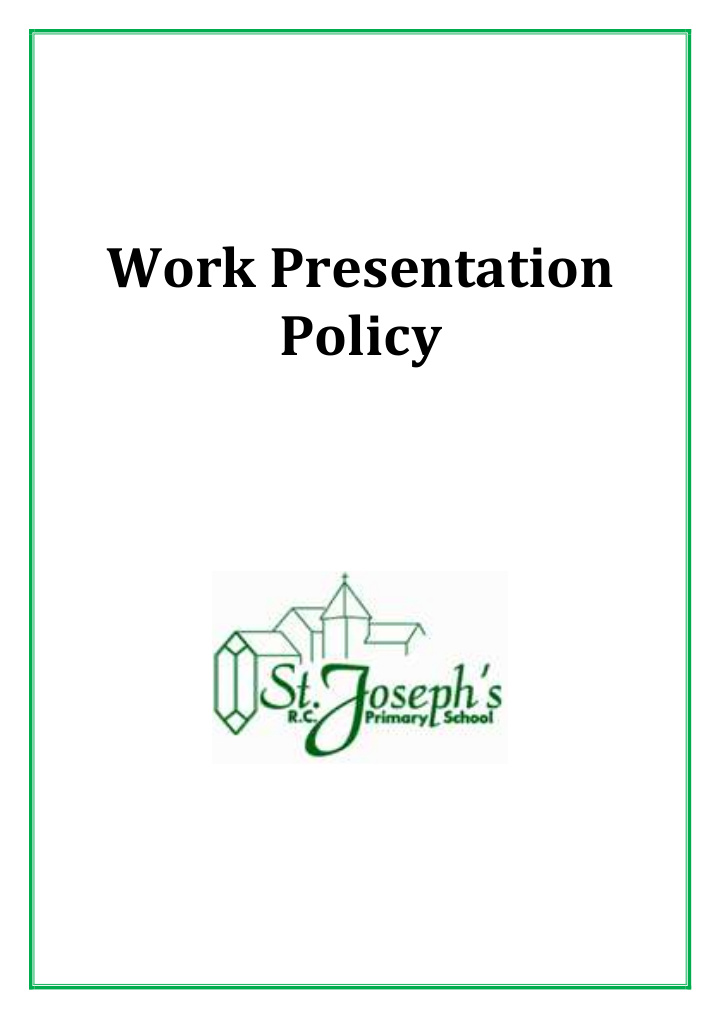



Work Presentation Policy
Statement of Aims - At St Joseph’s RC Primary School we are constantly seeking to raise standards in all aspects of Teaching and Learning. We aim to establish high expectations and to take pride in everything we do. The presentation of pupil’s outcomes in books forms a core part of this. We believe that pupil’s books form a record of the teaching and learning that has taken place during an academic year and as such needs to reflect a progression of personalised learning opportunities, as well as evidence of pupils making effort and taking pride in their outcomes. This policy was created through a combination of best practise and sharing of ideas and solutions in a range of meetings with groups of staff. Our policy clearly states our agreed expectations for presentation at St Joseph's and includes all necessary appendices to fulfil all aspects of the policy. Across all year groups, we believe that adults should ensure that: Presentation needs are modelled so that pupils can achieve success. This includes Layout and title. • An expectation of neat and presentable handwriting in line with the school • policy. Agreed systematic recording methods i.e. one digit, one square. • • That all pupils will be included in demonstrating good practise and made aware of their efforts and improvements. • Differentiation is expected across all year groups and individuals. Page | 2
Having agreed the policy we will monitor standards closely, including: The Presentation Policy will be part of Book Scrutinies • Learning Walks • Whole school display • We believe that children should: Read and respond in Green Pen to the comments made by adults in their books. • Take pride and care in presentation of their books. • Underline titles using a ruler and never leave unnecessary gaps. • Stick work sheets/learning objects in books neatly. • • Take time to finish off work where appropriate. • Cross out mistakes using a pencil. • Not doodle or scribble on the cover or inside their books. Page | 3
We believe that children should: Use quality writing equipment appropriate to the year group (Year 5 & 6 have the • opportunity to use pens once they have developed a consistent style). • Use pencils for drawings or diagrams. • Pupils should be expected to record the learning intention and full date (short date for Maths) at the beginning of each piece of recorded learning. Younger and less able pupils will be supported to establish these routines. Erasers will be discouraged; errors can be scored with one line. However teachers • and support staff can use discretion when they feel it would enhance the quality of work or motivate the pupils to make greater progress. In Key Stage One - • When writing the date we: o Date all work with a hand written short date, scribed date, computer generated date or date stamp building to write the full date in Literacy by the end of Year 2. o Place dates in the right hand corner of the page. o Underline the date with a pencil and ruler. o Miss a line after the date. o Write the long date for Literacy work and short date for Maths work. • When writing the titles we: o Write short and child friendly ‘Learning Objective’ as the title. o Have handwritten, scribed or computer generated titles, as is most appropriate for the class, child and activity. o Always begin with the Learning Intention. o Underline the title with a pencil and ruler. o Miss a line after the title. Always use pencil in books although other writing materials are available for writing tables and incidental writing activities. • All books have labels and essential points to consider include: Pre-prepared labels are available for all books. o Labels show the child’s full name, subject, class, name and book number. o Page | 4
In Key Stage Two - When writing the date we: • o Date all Numeracy work with a hand written short date. o Date all Literacy based work with a handwritten long date. o Place dates in the left hand corner of the page. o Underline the date with a pencil and ruler. o Miss a line after the date. o Differentiation can include Key Stage One variations. • When writing the titles we: o Write short and child friendly ‘Learning Objective’ as the title. o Always begin with the Learning Intention. o Underline the title. o Miss a line after the title. o Differentiation can include Key Stage One variations. When underling dates and titles: • All children to use pencil and o ruler. Pencils or Pens are used: • All pupils in Year 6 and the o majority of Year 5 use pens. All drawing and diagrams o should be in pencil. All books have labels and book covers, essential points to consider include: • Pre-prepared labels are available for all books. o Labels show the child’s name, subject, class, name and teacher’s name. o Margins: • Where a margin is missing, then a line should be drawn. o Maths should be 2cm wide o All other margins should be 1inch wide. o Page | 5
Recommend
More recommend